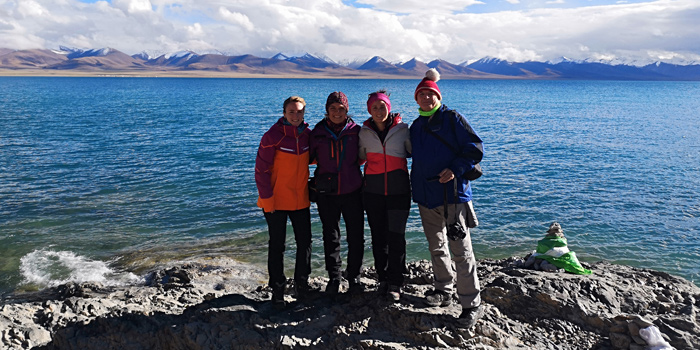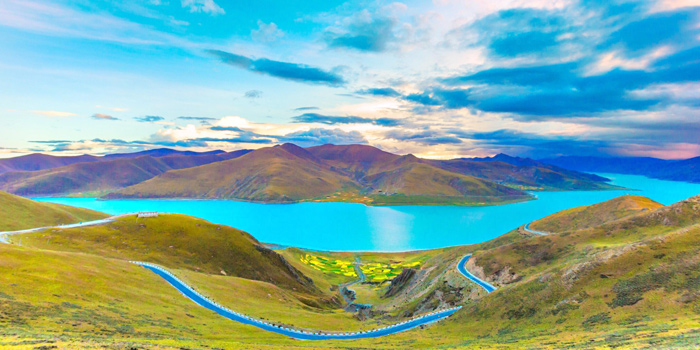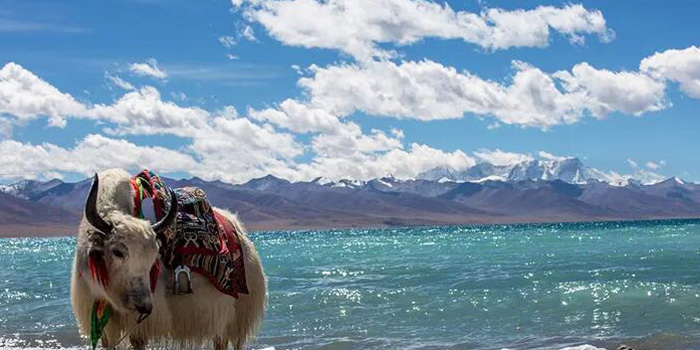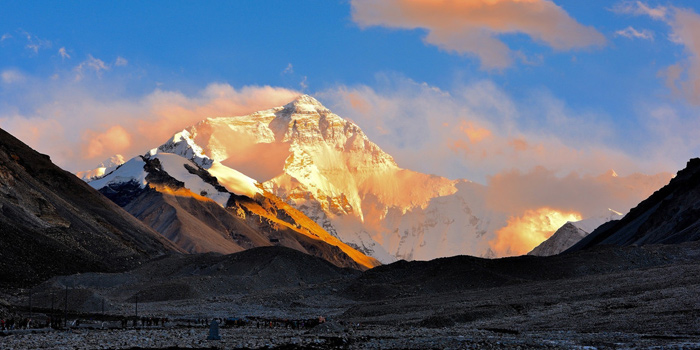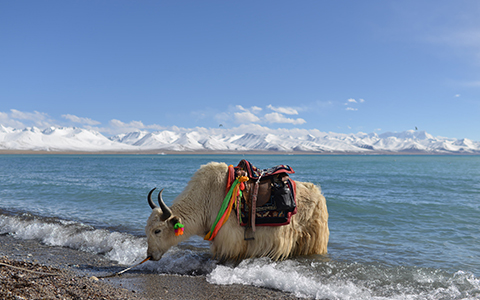Yamdrok Lake or Namtso Lake: which one is better for different travelers?
Yamdrok Lake and Namtso Lake, together with Lake Manasarovar are believed as the three most sacred lakes in Tibet. Regardless of their religious and spiritual aspects, merely a glimpse at any view of them is enough to trigger the recognizable tremble in your heart.
So, which one is better to choose for different travelers is seemingly become a tough question that baffles most of the visitors in Tibet.
Before you make the decision, just follow us to get acquainted with the top things you need to know about Namtso Lake and Yamdrok Lake and make the optimal and well-suited plan for your trip.
 1. Basic Things to Know about Namtso Lake and Yamdrok Lake
1. Basic Things to Know about Namtso Lake and Yamdrok Lake
 2. Namtso Lake and Yamdrok Lake have Different Shapes
2. Namtso Lake and Yamdrok Lake have Different Shapes
 3. Namtso Lake and Yamdrok Lake Exhibit Different Water Colors
3. Namtso Lake and Yamdrok Lake Exhibit Different Water Colors
 4. Namtso Lake and Yamdrok Lake Have Different Altitudes
4. Namtso Lake and Yamdrok Lake Have Different Altitudes
 5. Namtso Lake and Yamdrok Lake Have Completely Different Highlights for the Visit
5. Namtso Lake and Yamdrok Lake Have Completely Different Highlights for the Visit
 6. Namtso Lake and Yamdrok Lake Have Slight Differences in the Best Tourist Seasons.
6. Namtso Lake and Yamdrok Lake Have Slight Differences in the Best Tourist Seasons.
 7. Visiting Namtso Lake Requires more Time and Expense than Visiting Yamdrok Lake
7. Visiting Namtso Lake Requires more Time and Expense than Visiting Yamdrok Lake
1. Basic Things to Know about Namtso Lake and Yamdrok Lake
Among the three major sacred lakes in Tibet, Yamdrok Lake and Namtso are the two lakes closest to Lhasa. Yamdrok Lake is situated in the southwest of Lhasa, approximately 130 kilometers away, while Namtso Lake is located to the north of Lhasa, about 240 kilometers away and can be reached in 3 hours via a high-speed highway.
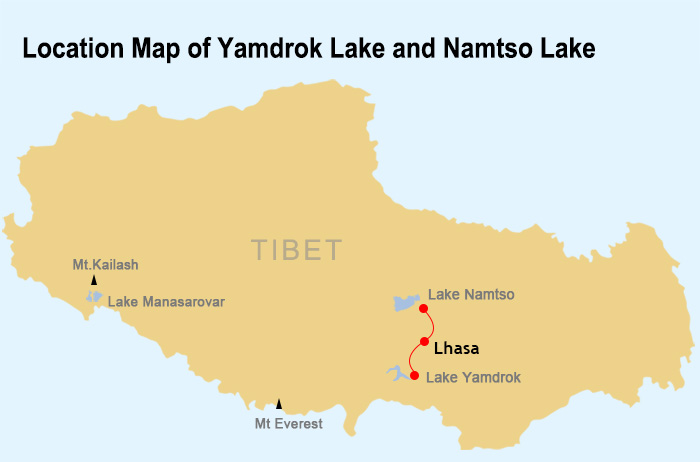 Location Map of Yamdrok Lake and Namtso Lake
Location Map of Yamdrok Lake and Namtso Lake
Both are renowned as sacred lakes in Tibet, and they offer boundless and incredibly sacred natural beauty. For tourists traveling to Lhasa who want to explore these lakes, it can be quite challenging to choose between them.
It's almost as if you can't bear to miss either. So, which one should you ultimately choose?
The table below provides information that might assist you in making your decision.
| Namtso Lake | Yamdrok Lake | |
| Location | Northern part of Damxung County, Lhasa city | Gonggar County, adjacent to 307 Provincial Road, Shannan City |
| Elevation | 4718 meters | 4441 meters |
| Lake Type | Saline lake | Saline lake |
| Maximum Depth | 120 meters | 60 meters |
| Area | 1940 square kilometers | 638 square kilometers |
| Distance from Lhasa | 250 kilometers, 4-5 hours by car | 110 kilometers, 2-3 hours by car |
| Ticket Price | 120 yuan | 60 yuan |
| Opening Hours | 06:00-18:00 | All day |
| Recommended Visit Duration | 1-2 days | 1 day |
| Best Visiting Season | June to September | All year round, with June to September being the best time. |
2. Namtso Lake and Yamdrok Lake have Different Shapes
Lake Namtso, as the second largest lake in Tibet, has a shape that closely resembles a rectangle, covering an area of 1940 square kilometers. When you travel to Namtso Lake, it seems almost boundless. The water of Lake Namtso can be quite turbulent, even showing tidal phenomena. When viewed from the lakeshore, you can hardly see the edges, giving the impression of being in a paradise of the sea, which is why it's also referred to as the "Heavenly Lake."
In contrast to other lakes in Tibet, Yamdrok Lake is a barrier lake formed by the blockage of a riverbed by debris flows. Its shape is distinctly different from other lakes. The entire lake surface is divided by hills into several smaller lakes, with over 20 small islands scattered throughout, each one independent on the water's surface. This creates a winding and diverse shoreline and a variety of lake forms, giving the lake a unique and ever-changing aesthetic.
3. Namtso Lake and Yamdrok Lake Exhibit Different Water Colors
Yamdrok Lake, also known as the "Turquoise Lake," earns this reputation due to the ever-changing and rich layers of color in its waters. Being a high-altitude barrier lake, the lake bottom consists of the crevices and gullies of the surrounding mountains. As a result, the lake bed varies in depth across the same body of water.
 Enjoy the stunning view of the turquoise Lake Yamdrok
Enjoy the stunning view of the turquoise Lake Yamdrok
When sunlight illuminates the surface of Yamdrok Lake, it creates a dream-like spectrum of colors. The varied depths caused by the mountainous terrain beneath the lake result in a surface with distinct and ever-changing shades, transitioning from light green to medium green, turquoise, and even peacock blue. The Yamdrok Lake, under the sunlight, appears like a jewel, full of dreamy hues. Because the lake is divided by numerous islands, its water is relatively calm, with very few ripples, enhancing the tranquility and layered appearance of its colors.
On the other hand, Namtso Lake boasts an average depth of 39.2 meters, with a lake bottom less complex than that of Yamdrok Lake, resulting in a less colorful and variable lake surface. Namtso Lake resembles more of a vast expanse of pale blue, almost like a tear of a celestial being. The entire vast lake surface is predominantly a pale blue, with only slight color variations possibly visible along the shores.
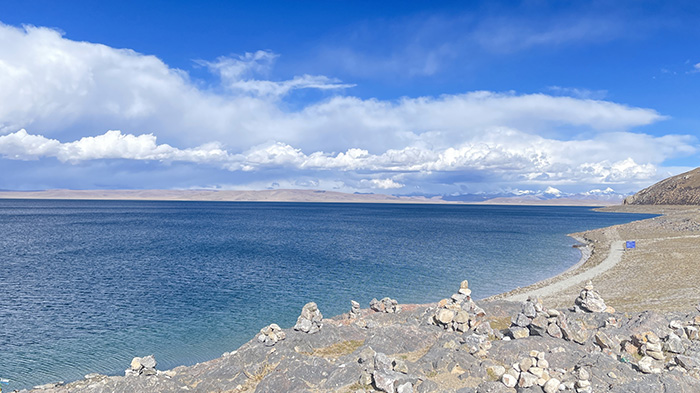 The heavenly Lake Namtso is like a blue ocean.
The heavenly Lake Namtso is like a blue ocean.
Lake Namtso resembles a massive, clear blue sapphire, free from impurities, with crystal-clear and profound waters exuding a timeless beauty. The extensive and boundless lake surface, coupled with the relentless winds of the high plateau, turn Namtso Lake into a true, tumultuous sea. Standing by the lake, you can experience the illusion of being at the seaside, as the waves lap against the shore, creating a sense of being by the sea.
4. Namtso Lake and Yamdrok Lake Have Different Altitudes
Namtso Lake, situated at an impressive altitude of approximately 4,718 meters (15,479 feet), is one of the world's highest saltwater lakes. In contrast, Yamdrok Lake, while still high at approximately 4,441 meters (14,570 feet), is slightly lower. The higher altitude of Namtso Lake often leads to a more pronounced impact on visitors.
Tourists at Namtso Lake commonly report experiencing symptoms of altitude sickness, such as dizziness, shortness of breath, and headaches, which can be challenging to acclimatize to in such a lofty location.
Conversely, visitors to Yamdrok Lake, with its comparatively lower altitude, generally encounter milder and more manageable symptoms, allowing for a more comfortable and enjoyable experience.
The degree of altitude sickness can vary depending on the lake's altitude, affecting tourists' overall enjoyment of these stunning Tibetan lakes. Therefore, it's essential to prevent altitude sickness when visiting any lake in Tibet.
5. Namtso Lake and Yamdrok Lake Have Completely Different Highlights for the Visit
Yamdrok Lake is distinctive for its numerous islands and smaller lakes. You can drive along its 250-kilometer shoreline, enjoying the beauty of Yamdrok Lake from various viewpoints on different observation decks. Some areas resemble an ocean, some appear as bays, and others resemble deep pools, each angle presenting a different view of the lake.
Along the lake's shores, you'll find monasteries and villages, with opportunities for close encounters with wildlife and observing yaks and sheep grazing leisurely in the lakeside pastures. Additionally, the observation deck at Karola Glacier, located on the lake's shore, provides a spectacular view of the majestic Noijin Kangsang Peak of Himalaya.
See the ultimate guide for visiting Yamdrok Lake
Namtso Lake, on the other hand, resembles an expansive ocean with a shoreline stretching for 320 kilometers, forming an almost elliptical lake. Since Namtso Lake is located within the Qiangtang Nature Reserve, most of its shoreline is not open to tourists.
Currently, only the eastern part of Namtso Lake's shoreline is open to visitors, and the previously popular Northern Shore's Nagenla Pass is closed for environmental reasons. Nevertheless, the vast expanse of the lake, lush grasslands, turquoise lake water, and the distant, encircling Nyenchen Tanglha Mountains create an exceptionally beautiful scene rarely seen in Tibetan travel. Especially during sunrise and sunset, the golden sunlight on the lake and the mountains makes it feel like you are in a fairyland. Also, you may come across local Tibetan doing the Namtso Kora around the lake.
6. Namtso Lake and Yamdrok Lake Have Slight Differences in the Best Tourist Seasons.
In Tibet, the best time to visit lakes is during the summer months, from June to September. During this period, the lakes are at their fullest, with lush greenery on the shores, herds of cattle and sheep, and distant snow-capped mountains that never melt. Both Yamdrok Lake and Namtso exhibit these typical features.
However, the situation is different in the winter months (November to March).
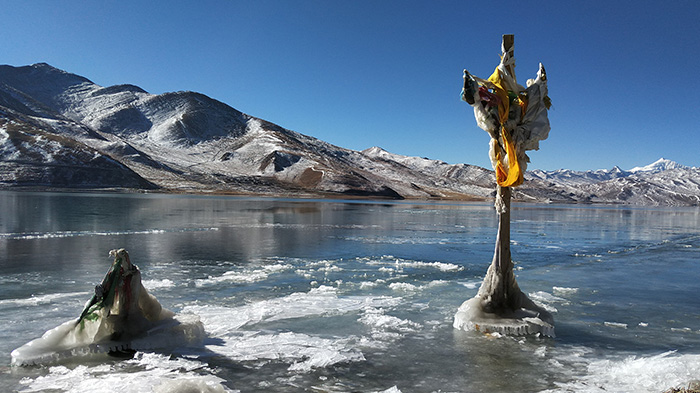 Lakes in Tibet can freeze during the winter months
Lakes in Tibet can freeze during the winter months
You can still visit Yamdrok Lake in winter. Even when the lake surface is frozen, it presents a unique beauty. Underneath the transparent ice, you can still see the deep blue lake water, and the cracks in the ice layer appear like frozen blue crystals, resembling a blue gemstone filled with ice patterns. Standing at the Kamba La Pass, which is at an elevation of 4,990 meters, and looking out at Yamdrok Lake, it feels like being in a blue ice and snow world.
Namtso Lake, on the other hand, is different. In the winter, the lake surface at Namtso freezes, and the lake waters no longer surge, which means that you can only enjoy the vast white expanse of the frozen lake surface and the snowy scenery along the shore. The essential pass to get to Namtso, the Nagenla Pass (at an elevation of 5,190 meters), often becomes impassable in the winter due to snow, making it impossible to reach Namtso.
So, if you want to admire the lake's beauty at "Heavenly Lake" Namtso, it's better to visit during the summer. If you are traveling to Tibet in the winter, then Yamdrok Lake might be the better option.
7. Visiting Namtso Lake Requires more Time and Expense than Visiting Yamdrok Lake
Yamdrok Lake is only about 110 kilometers away from Lhasa, and the journey takes approximately 3 hours, with visits typically lasting 1-3 hours. This allows you to easily make a round trip from Lhasa on the same day. If you plan to go to Shigatse or Everest Base Camp, Yamdrok Lake is a must-visit attraction that you can include in your itinerary without requiring extra time.
However, Namtso Lake is relatively farther from Lhasa, at around 250 kilometers, and the one-way journey takes 4-5 hours. To fully appreciate the landscape and have a good viewing experience, it is generally recommended that tourists allocate at least 2 days for the visit. This way, you can avoid the fatigue of long car rides. Typically, you can choose to stay overnight in Damxung, and on the second day, return to Lhasa, with opportunities to visit Chubu Temple or Tashidor Monastery on the way.
From a cost perspective, visiting Namtso Lake is slightly more expensive. Firstly, Namtso Lake is farther from Lhasa, and transportation costs in Tibet are usually calculated based on the number of days and the distance traveled. The round trip from Lhasa to Namtso covers nearly 500 kilometers, so the transportation cost is correspondingly higher, approximately 50% more than the cost of visiting Yamdrok Lake.
Additionally, entering the Namtso scenic area requires paying an entrance fee and a fee for the sightseeing bus, totaling around 210 yuan per person, while visiting Yamdrok Lake only requires a 60 yuan per person ticket.
Conclusion
when touring Tibet, both Yamdrok Lake and Namtso are excellent destinations, each with its unique characteristics that are difficult to compare. They offer distinctive features in terms of scenery, lake water colors, and the overall viewing experience.
If you have limited time, you can choose to spend a day visiting Yamdrok Lake. If you wish to visit Namtso Lake, it's generally advisable to allocate at least two days. Of course, if you have lots of time, think about visiting both of these sacred lakes in Tibet, among the Three Great Sacred Lakes. After all, each of Tibet's lakes has its uniqueness and is worth cherishing.
In summary, no matter which lake you choose to visit, the beautiful Tibetan lakes will leave a deep impression, becoming unforgettable memories and offering an indelible experience of Tibet travel.

With exceptional passion and outstanding leadership, Mrs. Catherine has dedicated herself to Tibet inbound tourism and China tour for 15 years. As one of the handful females who see great potential of Chinese inbound tourism, Catherine has made great contribution to promoting Tibet tourism and enhancing the employment of Tibetans and prosperity of local Tibetan community.
Over the years, she travelled overseas with Tibet Tourism Bureau many times to promote Tibet tourism. Currently, Catherine works as the marketing director of Tibet Vista, an opinion leader behind the whole team of Tibet Vista.
Related Articles & Posts
Most Popular Tibet Tour Packages
-

Lhasa - Gyantse - Shigatse - Everest Base Camp - Shigatse - Lhasa
USD939
View Details -

Lhasa - Gyantse - Shigatse - E.B.C - Saga - Kailash Trek - Darchen - Lake Manasarovar - Saga - Gyirong - Tingri - Lhasa
USD2059
View Details -

10 Days Lhasa to Everest Base Camp and Namtso Lake Small Group Tour
Lhasa - Gyantse - Shigatse - EBC - Shigatse - Lhasa - Namtso Lake - Damxung - Lhasa
USD1289
View Details -

8 Days Driving Across Himalaya Overland Adventure from Kathmandu to Lhasa
Kathmandu - Gyirong - Everest Base Camp - Tingri - Shigatse - Gyantse - Lhasa
USD1069
View Details -

4 Days Lhasa Impression Small Group Tour: Explore the Heart of Tibet and Mingle with the Locals
Lhasa
USD509
View Details -

Lhasa - Gyantse - Shigatse - Everest Base Camp - Gyirong - Kathmandu
USD979
View Details -

Lhasa - Gyantse - Shigatse- Lhasa
USD799
View Details -

13 Day Lhasa, Mt. Everest, Mt. Kailash, Lake Manasarovar and Kathmandu Adventure Tour
Lhasa - Gyantse - Shigatse - EBC - Saga - Darchen - Kailash Trek - Darchen - Saga - Gyirong - Kathmandu
USD2059
View Details


.jpg)



